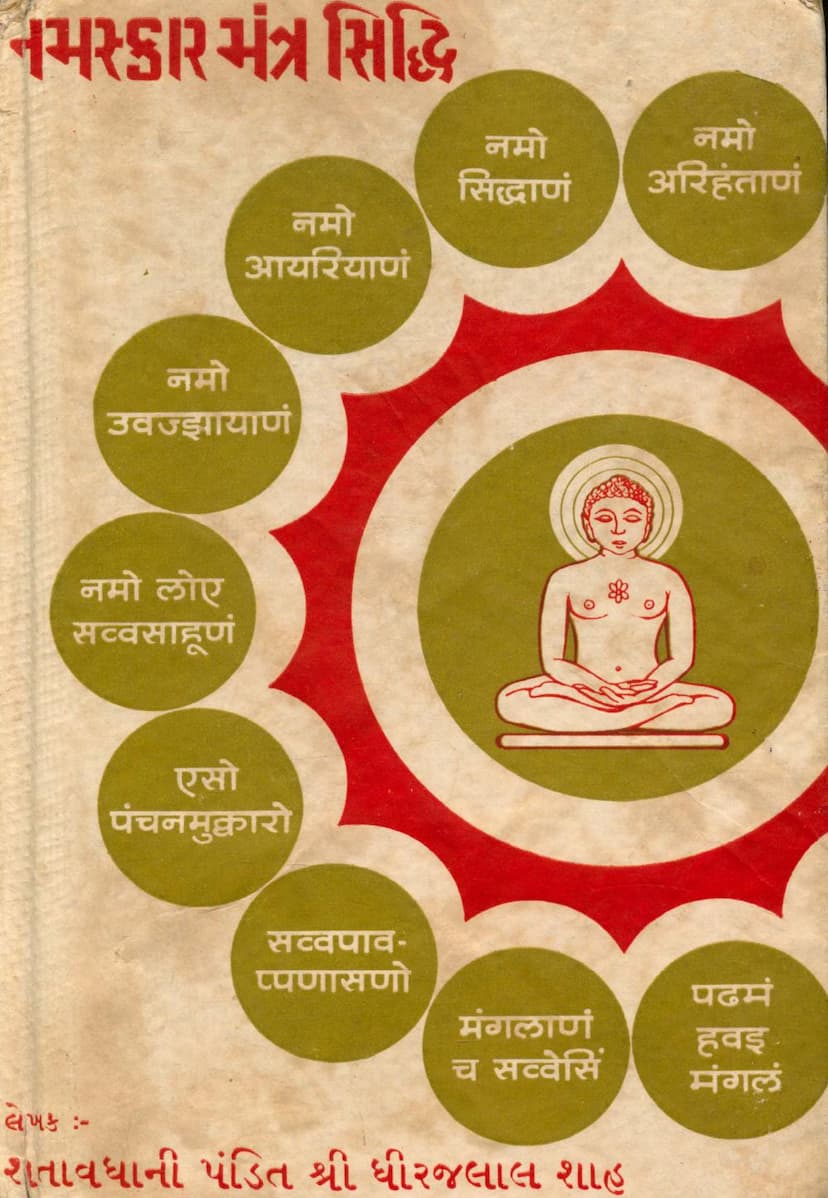Namaskar Mantra Siddhi
Added to library: September 2, 2025

Summary
This comprehensive summary outlines the Jain text "Namaskar Mantra Siddhi" by Dhirajlal Tokarshi Shah, published by Narendra Prakashan. The book delves deeply into the significance, practice, and attainment of spiritual powers through the Namaskar Mantra, a fundamental Jain chant.
Here's a breakdown of the book's content based on the provided text:
Core Subject: The Namaskar Mantra (also known as the Navkar Mantra or Namo Mantra) and its "Siddhi" (accomplishment, perfection, or spiritual realization).
Author: Dhirajlal Tokarshi Shah, described as a "Shatavadhani Pandit" (a scholar capable of memorizing and recalling vast amounts of information), indicating his profound knowledge and intellectual capabilities. The book is presented as part of the "Dhirajlal Tokarshi Shah Amrut-Mahotsav Granthmala," celebrating his significant contributions.
Publisher: Narendra Prakashan, Mumbai.
Key Themes and Content:
-
Introduction to the Namaskar Mantra: The book begins by presenting the mantra itself:
- Namo Arihantanam (I bow to the Arihants)
- Namo Siddhanam (I bow to the Siddhas)
- Namo Aayariyanam (I bow to the Acharyas)
- Namo Uvvajjhayanam (I bow to the Upadhyayas)
- Namo Loe Savva-Savhanam (I bow to all the Sadhus in the world)
- Aiso Panch-namukkaro, Savva-pavappanasano (This five-part salutation destroys all sins)
- Mangalanam cha Savvesim, Pathamam Havai Mangalam (It is the first and foremost auspiciousness of all auspicious things)
-
Etymology and Names: The text explores various names and interpretations of the mantra, including "Navkar," "Namokar," "Panch-namo," "Panch-namokaro," and "Namaskar." It discusses how the "Navkar" name became widely popular and its practical usage in daily life.
-
Significance and Glory: A significant portion of the book is dedicated to elaborating on the unparalleled importance and glory of the Namaskar Mantra. It is described as:
- The essence of Jainism and the core of the Jain Agamas.
- An unfathomable and immense entity.
- A mantra with inexplicable power that transcends the limitations of normal prayers and practices.
- Possessing the potential to grant both material (artha, kama) and spiritual (moksha) benefits.
- Superior to all other mantras, scriptures, and spiritual practices.
- Capable of destroying all sins, removing obstacles, and bestowing auspiciousness.
- Described using profound metaphors like a wish-fulfilling tree (Kalpavriksha), wish-fulfilling vessel (Kamakumbha), wish-fulfilling cow (Kamadhenu), and a wish-fulfilling jewel (Chintamani Ratna).
-
Siddhi (Accomplishment): The book extensively covers the concept of "Siddhi" achievable through the mantra. This includes:
- Spiritual Siddhi: Attaining liberation (moksha), purification of the soul, overcoming vices like anger, pride, deceit, and greed, and realizing the true nature of the self.
- Material Siddhi: Gaining wealth, prosperity, success, fame, influence, and protection from harm, diseases, and negative forces.
- Eightfold Siddhis: The text hints at the attainment of the "Ashta Siddhis" (eight great accomplishments) through diligent practice, although the specific details of each siddhi are not elaborated in the provided excerpts.
-
Sadhana (Practice): The book details the practical aspects of performing the mantra sadhana, emphasizing its necessity for achieving spiritual and material goals. Key elements discussed include:
- Importance of Sadhana: Highlighting that accomplishment is directly proportional to the effort and dedication in practice.
- Location for Sadhana: Recommending sacred places like Jain temples, forests, riverbanks, and peaceful environments.
- Method of Sadhana: Explaining the importance of correct pronunciation, intention, and posture.
- Key Components: Discussing the crucial elements of Smaraṇa (remembrance), Japa (recitation), and Dhyana (meditation) as integral parts of mantra practice.
- Dhyana Vidhi (Meditation Method): Detailed instructions are given on how to perform the meditation, including visualizing the mantra in various forms (Akshara, Pada, Rupa).
- Mantra Aushadha (Mantra as Medicine): The mantra is presented as a potent remedy for worldly ailments and spiritual impurities.
-
Purity and Discipline: The text stresses the need for purity of body, mind, and actions during sadhana. This includes adhering to ethical principles, maintaining purity of diet, and cultivating virtues like patience, humility, and devotion.
-
The Power of Faith and Devotion: The book emphasizes that true accomplishment comes not just from ritualistic practice but also from unwavering faith and sincere devotion to the mantra and the principles it represents.
-
Specific Mantras and Yantras: While the core is the Namaskar Mantra, the book also briefly touches upon other related mantras and the use of yantras (sacred diagrams) for specific purposes, suggesting a broader framework of mantra science within Jainism.
-
Testimonials and Examples: The text likely includes stories and examples of individuals who achieved extraordinary results through the practice of the Namaskar Mantra, reinforcing its efficacy. The introduction of Ramanlal Vadilal Shah, to whom the book is dedicated, and the numerous individuals and organizations mentioned for their support, highlight the community's engagement with this spiritual knowledge.
-
Structure of the Book: The book is divided into several sections ("Khand") covering "Sadhya Khand" (the subject of attainment), "Sadhana Khand" (the practice), and "Siddhi Khand" (the accomplishment). It also includes sections on "Swadhyaya" (self-study) with hymns, songs, and verses related to the mantra.
Overall Impression:
"Namaskar Mantra Siddhi" is a profound and comprehensive guide that elevates the Namaskar Mantra from a mere chant to a powerful tool for spiritual and worldly advancement. It underscores the mantra's efficacy as a means to overcome obstacles, achieve desires, purify the soul, and ultimately attain liberation, a central goal in Jain philosophy. The author's extensive research and deep devotion are evident throughout the text, aiming to rekindle faith and understanding in this fundamental Jain practice.